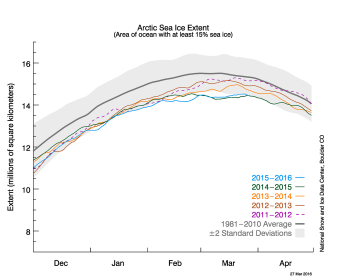http://nsidc.org/arcticseaicenews/
Another record low for Arctic sea ice maximum winter extent
March 28, 2016
Arctic sea ice appears to have reached its annual maximum extent on March 24, and is now the lowest maximum in the satellite record, replacing last year’s record low. This year’s maximum extent occurred later than average. A late season surge in ice growth is still possible. NSIDC will post a detailed analysis of the 2015 to 2016 winter sea ice conditions in early April.
That analysis, which I will post as soon as it’s available, will feature a chart comparing the mean ice extent for the entire month of March compared to all previous Marches in the 1979-2016 satellite record. This smoothed statistic, which summarizes an entire month’s figures, is much more robust than the daily values discussed here due to the daily random variation introduced in ice extent by weather and hydrological conditions at high latitudes. Remember, although the sun has been moving further and further North since the Solstice in December, it is still very cold in the Arctic.
Overview of conditions
On March 24, 2016, Arctic sea ice likely reached its maximum extent for the year, at 14.52 million square kilometers (5.607 million square miles). This year’s maximum ice extent was the lowest in the satellite record, with below-average ice conditions everywhere except in the Labrador Sea, Baffin Bay, and Hudson Bay. The maximum extent is 1.12 million square kilometers (431,000 square miles) below the 1981 to 2010 average of 15.64 million square kilometers (6.04 million square miles) and 13,000 square kilometers (5,000 square miles) below the previous lowest maximum that occurred last year. This year’s maximum occurred twelve days later than the 1981 to 2010 average date of March 12. The date of the maximum has varied considerably over the years, occurring as early as February 24 in 1996 and as late as April 2 in 2010.

http://nsidc.org/arcticseaicenews/files/2016/03/asina_N_stddev_timeseries1-350×280.png
Again, recall the all time record low for summer ice was 2012. I think this summer we will have a good chance of breaking that record once again. The low ice record is broken, on the average, every 4 or 5 years. The high ice record has never been broken in the years we have been taking satellite records.
-
April Fool
-
Incapable of addressing the data?
-
It looks like the joke's on you, Steve.
- No the joke was a joke, but you and your side kick had to turn it into a drama as usual
-
Watts is on the payroll for the Heartland institute...
- The picture was taken August 1958, and NOT at the north pole...
-
Incapable of addressing the data?